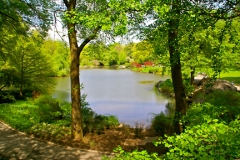
NEW YORK — Can it be 40 years since Rod Laver borrowed a dime from me? Afraid so. It wasn’t a “Brother, can you spare a dime?” plea, however. After all, Laver had moments before won a tennis tournament called the US Open, and was handed a check for $ 16,000. (The same event that will shortly endow a man and a woman with $ 1,600,000 a piece. Yes, you can get rich playing this fuzzy ball game, but you have to practice an awful lot.)
Anyway, Laver, the brilliant Australian lefty, was more nervous after winning than in defeating compatriot Tony Roche for the title at swampy Forest Hills. His wife, Mary, was about to have a baby, and he wanted to phone her. In that day, well prior to mobile phones, his only option was a pay phone in the press box, requiring a dime to launch a collect call. Glad I had one.
The baby boy, scheduled for arrival any minute, defied the physician’s prediction and was eventually about 10 days late. “I’d never go to a race track with that guy,” Laver laughs.
Anyway the big public event of a wet Monday was his US triumph, closing that rarest of tennis accomplishments – a Grand Slam. During 1969 he had won all four majors: Australian, French, Wimbledon and US championships. Not too much was made of it at the time, but as the years passed, and no man came close, the Slam became the game’s Everest. And so Laver will be saluted on his Slam’s 40th anniversary Sunday at Flushing Meadows.
On the year of Rod’s birth, 1938, Californian Don Budge circled the first Slam. Another Californian, Maureen Connolly, did it in 1953, and two more women, Aussie Margaret Smith Court in 1970, and German Steffi Graf in 1988.
Redheaded Laver, known as “Rocket” to his colleagues and tennis junkies, caught up with Budge in the male precinct in 1962. But it didn’t mean world supremacy because in that divided era, the best players were pros, outlaws ineligible to enter the four majors.

“I was an amateur,” Rod says, “and I’d done all that I could there. But I wanted to make some money by turning pro in 1963, and testing myself against the best – Ken Rosewall, Lew Hoad, Pancho Gonzalez to name the top three.”
Pro tennis then was a shaky proposition, a demanding life of one-night stands throughout the world with money enough for only a small cast, frequently in deplorable settings. Like Khartoum where we played outdoors at night and when enough bugs clotted the lights the show was over. “The public accepted it, as a natural conclusion. We split $ 1000 four ways,” he recalls. “Sometimes we didn’t get paid at all, if it wasn’t a good crowd. ”Playing way up high in La Paz [elevation 12,000 feet], the balls flew like pigeons, and we got nosebleeds. I won and got a $ 600 watch, all they had for us.”
Aussies Hoad and Rosewall broke open their piggy banks to guarantee Laver a decent wage because their tour was about to fail. They barnstormed five years, keeping the pro game alive so that it could blossom in the light of today. At last open tennis dawned in 1968. Though Laver had lost five prime years in beating the bushes, he knew what he wanted –“a Grand Slam that included everybody.”
That was his 1969 holy grail at age 31. In each of the four finals he beat a Hall of Famer-to-be. He was going home to Queensland where he’d grown up on a cattle ranch and fallen off a few horses in the process. Brisbane was the launching site for his Slam, the victim Spaniard Andres Gimeno.
Next came the French and overcoming his slick nemesis, Rosewall, a master of clay. Then came Aussie John Newcombe at Wimbledon, and a difficult lefty, Tony Roche in New York. Only 3708 fans showed up for the final to sit through drizzles and rain delays at Forest Hills. But they were warmed by Laver’s incendiary shotmaking and Roche’s resistance.

After losing the first set, 9-7, Rod got permission to wear the spikes he always packed. Presto, he became a bog running dandy, his Astaire-like footwork, serving-and-volleying carrying the day, 7-9, 6-1, 6-2, 6-2, for the Slam bam man whose records hold up today. He won 14 other titles in ’69, always played doubles, and glittered in Boston, winning the US Pro at Longwood five times between 1964 and 1969. How many more than his 11 major singles would he have nailed during his five years as a banned renegade?
Only 5-9, but swift, strong with a an ordinary body attached to a Godzillan left arm, he had every shot to play anywhere. Greatest of all? Quite possibly, but a silly argument. All you can be is the finest of your era. He was in his era, as Roger Federer appears to be now.
Rod is happy for Federer’s success, hopes Roger will keep him company one day with a Slam of his own. For now Laver is unique: two Grand Slams. But soft-spoken and modest about the whole thing.
He has come through a near fatal stroke of 1998, plays golf (10 handicap) and some tennis, lives in Southern California, and visits stroke patients, encouraging them in their rehab-ing which saved him.

He even survived the Grand Slam victory party in New York, an old Aussie custom dictating a beer for every every initial in the alphabet. “They may have reached Z,” Rod says, “but I’m still waiting to hear it. Or L. for that matter.”
—–
Rod Laver’s memoir, “The Education of a Tennis Player,” (written by Bud Collins) is published this week.
Leave a Reply